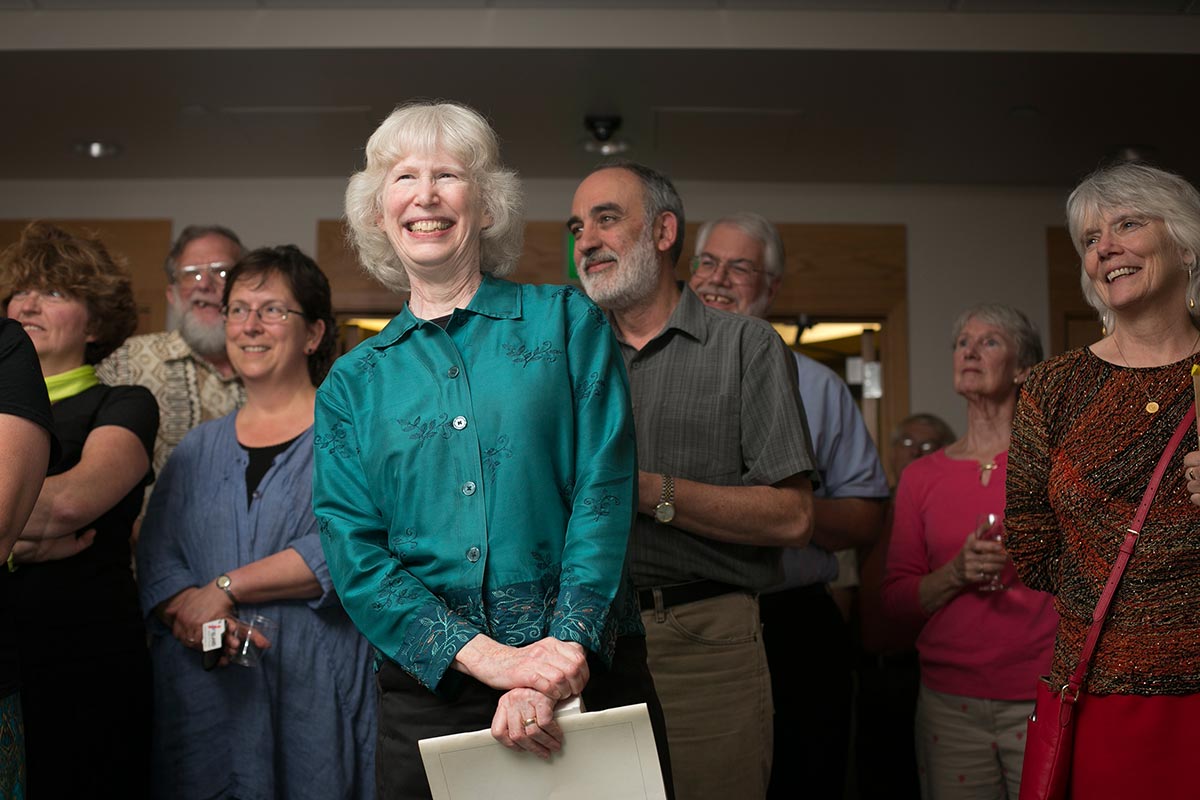One for the books: Library fetes retiring archivist Elaine Engst
By Daniel Aloi

For the past 20 years, Elaine Engst, M.A. ’72, steward of the University Archives, has been an ever-helpful, knowledgeable source and resource regarding all things Cornell.
In addition to helping faculty, students, staff and alumni with questions and research inquiries, she had a hand in establishing Cornell’s Human Sexuality Collection (among many other collections) and has been a keen interpreter of institutional history – most recently in the sesquicentennial exhibition “150 Ways to Say Cornell.”
At a retirement party June 17 in Kroch Library, historian Carol Kammen said Engst shared a “curiosity for whatever I was interested in. She has been a co-producer of everything I’ve been able to do.”
Among Engst’s first jobs at the library in 1979 was data entry as a technical services archivist. “In her interview, she said she had never used an electric typewriter. She turned out to be our fastest cataloger,” said Thomas Hickerson, former director of the Division of Rare and Manuscript Collections (RMC), a role Engst also would fill.
“I’d been a graduate student, I’d had a couple of kids,” she said. “It wasn’t entirely a career move – I needed a job. And it was something I immediately loved and thought I could be really good at. … It has been an enormous amount of fun, answering questions, figuring things out, the detective work of it all.”
David Brumberg, former director of the New York Historical Resources Center once based at Cornell, recalled Engst’s other early role, working on the New York Historical Records Inventory, a survey compiling descriptions of more than 24,000 collections in 1,100 archives. “Elaine has been the brains behind what has gone on in the library and in the larger archives world,” he said.
Gould Colman, whom Engst succeeded as university archivist after his retirement in 1995, said she “brought this university and its archive into the digital age.”
Engst set an example by being detail-oriented and worked with a diversity of people, said her successor, RMC collections assistant Evan Earle ’02, adding: “That expands our ability to expand our collections, working with people who send us their material. I really hope to emulate that.”
“One doesn’t have to look too hard or too long at major accomplishments in Rare and Manuscripts or in its earlier incarnations to find Elaine’s fine hand behind them,” said University Librarian Anne Kenney.
“By my reckoning you have 10 days left in your job,” Kenney said, presenting Engst with a box of business cards bearing her new title: the first Dr. Peter J. Thaler ’56 Cornell University Archivist.
“It’s more than fitting that you’re the first, considering the Thalers endowed your position in recognition of your truly extraordinary career at Cornell,” Kenney said. “You’ve shared 36 years with us, motivating and encouraging others, envisioning better ways to do things and implementing changes with grace, humor and style.”
Thaler, a retired surgeon, said from his home in Los Angeles that Engst had generously helped him on previous visits to RMC, and he welcomed the opportunity to support the archives.
“I first met Elaine at an event Cornell had in Philadelphia in the 1990s,” he said. “I remember her explaining how the library was going to digitize its collections.” Following Reunion Weekend 2001, “I went to the library, one of my favorite places on campus,” and inquired about Cornell’s collection on witchcraft. Engst “brought out a volume from the 14th century, a manifesto prepared by the Catholic Church on how to identify witches and how to deal with them. It was Andrew Dickson White’s original copy.”
Holding the book and seeing White’s notes in the margins, Thaler said, “to me was the most fascinating thing in the world. It just confirmed my belief that the university has one of the greatest libraries in the world. And that no matter how much is digitized, there will always be a need for paper.”
Media Contact
Get Cornell news delivered right to your inbox.
Subscribe